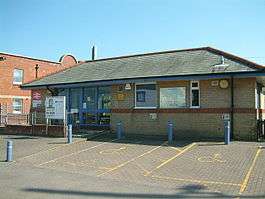Walton-on-the-Naze railway station
Walton-on-the-Naze railway station is one of the two eastern termini of the Sunshine Coast Line, a branch of the Great Eastern Main Line, in the East of England. It serves the seaside town of Walton-on-the-Naze, Essex. It is 70 miles 15 chains (113.0 km) down the line from London Liverpool Street.[1] Its three-letter station code is WON. The preceding station on the line is Frinton-on-Sea.
| Walton-on-the-Naze | |
|---|---|
 | |
| Location | |
| Place | Walton-on-the-Naze |
| Local authority | Tendring |
| Coordinates | 51.846°N 1.268°E |
| Grid reference | TM251214 |
| Operations | |
| Station code | WON |
| Managed by | Greater Anglia |
| Number of platforms | 1 |
| DfT category | E |
| Live arrivals/departures, station information and onward connections from National Rail Enquiries | |
| Annual rail passenger usage* | |
| 2014/15 | |
| 2015/16 | |
| 2016/17 | |
| 2017/18 | |
| 2018/19 | |
| History | |
| Key dates | Opened 17 May 1867 |
| Original company | Tendring Hundred Railway |
| Pre-grouping | Great Eastern Railway |
| Post-grouping | London and North Eastern Railway |
| National Rail – UK railway stations | |
| * Annual estimated passenger usage based on sales of tickets in stated financial year(s) which end or originate at Walton-on-the-Naze from Office of Rail and Road statistics. Methodology may vary year on year. | |

The station was opened by the Tendring Hundred Railway, a subsidiary of the Great Eastern Railway, in 1867.[2] It is currently managed by Greater Anglia, which also operates all trains serving the station.
History
The station was opened as Walton-on-Naze on 17 May 1867 by the Tendring Hundred Railway, then worked by the Great Eastern Railway (GER).[3] The GER acquired the Tendring Hundred Railway and the adjacent Clacton-on-Sea Railway on 1 July 1883. The Wivenhoe & Brightlingsea line was also absorbed by the GER on 9 June 1893.[4] The line later became part of the London and North Eastern Railway (LNER) in 1923 and then part of the Eastern Region of British Railways following nationalisation in 1948.
The station is the terminus of the short single-track branch off the Sunshine Coast Line at Thorpe-le-Soken. Only what was the "down" (coast-bound) platform remains in use following the electrification of the line.[5] There was a small locomotive shed at the station, and on 1 January 1922 this had an allocation of two GER Class Y65 2-4-2T engines.[6]
The shed was later converted into a coach-park.[7]
The station was renamed Walton-on-the-Naze in May 2007 to properly reflect the name of the town it serves.
Accidents and incidents
On 12 August 1987 a passenger train over-ran the buffer stops at Walton-on-Naze and became embedded in the station building. Six people and the train's driver were injured in the incident. The 1:05 pm service from Thorpe-le-Soken, formed of a single Class 313 unit, was severely damaged and an investigation blamed failure of its brakes as the primary cause of the accident. The driver was also deemed to have been at fault for not applying the emergency brake in addition to the normal brakes.[8]
Services
In 1929 the LNER introduced luxurious Pullman day excursion trips from Liverpool Street to various seaside resorts. The service known as the Eastern Belle served Felixstowe on Mondays, Frinton and Walton on Tuesdays, Clacton on Wednesdays, and Thorpeness and Aldeburgh on Thursdays and Fridays.[9] The service ended in September 1939 due to the outbreak of World War II.
The typical current service pattern is:
| Operator | Route | Rolling stock | Frequency | Notes |
|---|---|---|---|---|
| Greater Anglia | Colchester - Colchester Town - Hythe - Wivenhoe - Alresford - Great Bentley - Weeley - Thorpe-le-Soken - Kirby Cross - Frinton-on-Sea - Walton-on-the-Naze | Class 321 | 1x per hour | Monday-Saturday |
| Greater Anglia | Thorpe-le-Soken - Kirby Cross - Frinton-on-Sea - Walton-on-the-Naze | Class 321 | 1x per hour | Sunday |
Passengers for Clacton-on-Sea must change at Thorpe-le-Soken for a connecting service.
There are some additional services to and from London Liverpool Street during peak hours.
References
- http://www.s-r-s.org.uk/railref/ref-ge.html
- Allen, Cecil J (1975). The Great Eastern Railway (Third ed.). Shepperton: Ian Allan. p. 237. ISBN 07110 0659 8.
- Allen, Cecil J (1975). The Great Eastern Railway (Third ed.). Shepperton: Ian Allerton. p. 237. ISBN 07110 0659 8.
- Walsh, B.D.J. (September 1959). Cooke, B.W.C. (ed.). "The Great Eastern Line in the Tendring Hundred". The Railway Magazine. Westminster: Tothill Press Ltd. 105 (701): 641.
- Body, Geoffrey (1986). PSL Field Guide - Railways of the Eastern Region - Vol 1 : Southern Operating Area. Wellingborough: Patrick Stephens Limited. p. 175. ISBN 0-85059-712-9.CS1 maint: ref=harv (link)
- Hawkins, Chris; Reeves, George (1987). Great Eastern Railway Engine Shed Part 2. Didcot UK: Wild Swan. p. 379. ISBN 0 906867 48 7.
- Body 1986, p. 176
- http://www.railwaysarchive.co.uk/documents/HSE_WaltonOnTheNaze1987.pdf
- Watling, John (January 1992). "Pullman cars and the Great Eastern part 5". Great Eastern Journal (69): 6.
External links
| Wikimedia Commons has media related to Walton-on-the-Naze railway station. |
- Train times and station information for Walton-on-the-Naze railway station from National Rail
- Walton-on-the-Naze station in 1960
| Preceding station | Following station | |||
|---|---|---|---|---|
| Greater Anglia Sunshine Coast Line Walton branch | Terminus | |||